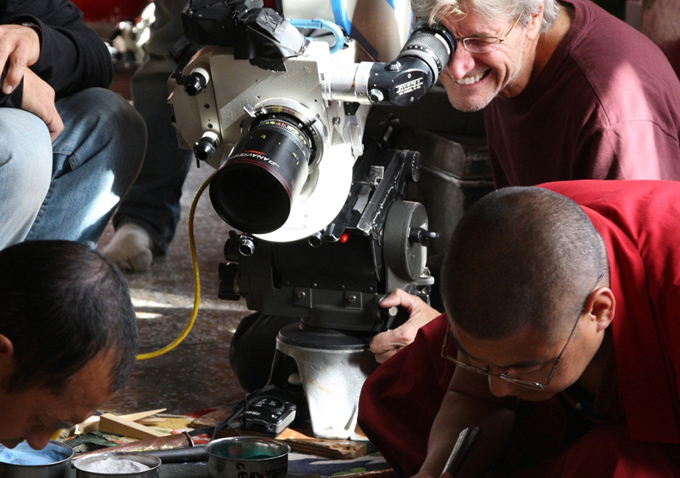 Just what is a non-verbal documentary anyway? If you appreciated the silent visual storytelling of "The Artist" or the cinematic majesty of Terrence Malick's nature cinematography in "The Tree of Life," or, if you're a fan of the cult 1992 documentary "Baraka," you'll be a fan of "Samsara," the latest effort from that film's director, Ron Fricke. Using the Tibetan word for "the ever turning wheel of life" as its title, the film chronicles the birth, life, death, destruction and rebirth cycles that occur on our planet in ways big and small.
Just what is a non-verbal documentary anyway? If you appreciated the silent visual storytelling of "The Artist" or the cinematic majesty of Terrence Malick's nature cinematography in "The Tree of Life," or, if you're a fan of the cult 1992 documentary "Baraka," you'll be a fan of "Samsara," the latest effort from that film's director, Ron Fricke. Using the Tibetan word for "the ever turning wheel of life" as its title, the film chronicles the birth, life, death, destruction and rebirth cycles that occur on our planet in ways big and small.
The film had its U.S. premiere at the Santa Barbara International Film Festival last week, screening to a packed house in the 2,000 seat Arlington Theater. Shot on 70mm film, over a period of four years in locations scattered across the globe, the footage captured by Fricke is unlike anything you will ever see — based simply on the sheer effort that it took to do so. His signature and innovative use of camera movement over time-lapse photography is visually breathtaking, interspersed with stunning slow motion film-portraits of various subjects along the journey. It has a rhythm and flow that ebbs like the tides, and a score that pulsates with a human heartbeat. The Arlington is outfitted with a 4K projector which showcased the crisp, luminous photography, and the result was a truly special cinematic experience.
 While "Samsara" travels the globe from Tibetan monks, to African tribesman, to Chinese factory workers, to Los Angeles' tangled web of freeways, to the destruction caused by Hurricane Katrina, and more, it maintains the themes of life and death, permanence and impermanence and the flow and rhythm of our world's energy throughout. It is bookended by images of Tibetan monks working on a detailed sand painting, which serves as a metaphor for the film, and creates a running thematic through-line. While the art is in the camera's manipulation of images, the story is in the way these images are put together, edited to create sentences, paragraphs and pages of script simply through their juxtaposition. The film is told through the technique Soviet filmmaker Sergei Eisenstein described as "intellectual montage" nearly 100 years ago. Eisenstein had specifically political and sensationalist cinematic goals with intellectual montage, and "Samsara" is both of those things as well, but in a way that it lulls you into belief. A simple camera tilt reveals that what you thought, is not, while the editing makes the connections with the imagery to create a finely woven tale. Parts of it feel distinctly like its non-verbal documentary predecessor, "Man With a Movie Camera," by Eisenstein's contemporary Dziga Vertov, which documented the day in the life of a Russian city and cinematographer using no words, and indeed, the concepts are similar, but "Samsara" takes the idea to new global and spiritual heights.
While "Samsara" travels the globe from Tibetan monks, to African tribesman, to Chinese factory workers, to Los Angeles' tangled web of freeways, to the destruction caused by Hurricane Katrina, and more, it maintains the themes of life and death, permanence and impermanence and the flow and rhythm of our world's energy throughout. It is bookended by images of Tibetan monks working on a detailed sand painting, which serves as a metaphor for the film, and creates a running thematic through-line. While the art is in the camera's manipulation of images, the story is in the way these images are put together, edited to create sentences, paragraphs and pages of script simply through their juxtaposition. The film is told through the technique Soviet filmmaker Sergei Eisenstein described as "intellectual montage" nearly 100 years ago. Eisenstein had specifically political and sensationalist cinematic goals with intellectual montage, and "Samsara" is both of those things as well, but in a way that it lulls you into belief. A simple camera tilt reveals that what you thought, is not, while the editing makes the connections with the imagery to create a finely woven tale. Parts of it feel distinctly like its non-verbal documentary predecessor, "Man With a Movie Camera," by Eisenstein's contemporary Dziga Vertov, which documented the day in the life of a Russian city and cinematographer using no words, and indeed, the concepts are similar, but "Samsara" takes the idea to new global and spiritual heights.
It's hard to describe "Samsara," aside from gushing about its technical achievements, which are many. The film itself is a rare artifact, due to the technical ability and will the filmmakers had to have to capture these images. You can't simply go out and recreate it. And while one can discuss the technical prowess of these shocking and beautiful images, it doesn't do justice to the spiritual cinematic power of this work. Scenes of worshippers at Mecca, or the moon traveling across a desert sky, or workers in a chicken factory are unlike anything you will ever see, yes, and they are visually dazzling, but that does not speak to the emotional power imbued within each frame. Fricke knows that for all of his computerized camera movements and time-lapse photography, sometimes resting on a close up of a Filipino inmate's eyes, a young African mother and child, or the single tear of a geisha slipping down her cheek is more emotionally powerful than anything technologically dazzling. Simply put, "Samsara" tells the story of our world, but onscreen, it is so much more than that. [A]

